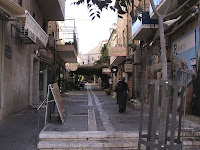“Boney was a warrior...”
 |
| Napoleon Bonaparte as First Consul |
Napoleon’s campaign to the Middle East
 |
| Ahmad Pasha al-Jazzar |
To the north
lay the Holy Land ruled from Acre by Ahmad Pasha “al-Jazzar” (the butcher). Napoleon reasoned that without at least a
truce with al-Jazzar it would be hard for him to maintain his hold on Egypt. He made the approach but did not receive a
reply. He felt that he had no option but
to set out on an expedition to defeat al-Jazzar.
Somehow the
fate of this expedition was already sealed by the time it reached the coastal town
of el-Arish in northern Sinai. The
French military intelligence was badly flawed.
Napoleon expected a town without any defences. He found a fortress there held by al-Jazzar’s
troops. He took el-Arish only after a twelve
day siege. It gave al-Jazzar valuable time to prepare the
defence of his headquarters in Acre. In
the course of the siege the bubonic plague that had broken out amongst the
Turkish troops also infected the French camp.
It was to have dire consequences.
The Siege of Jaffa
 |
| Napoleon visits plague victims |
Napoleon took his army north
to the port of Jaffa. By the time he
arrived some 4,000 Turkish soldiers had gathered there. He prepared for a siege and sent two French officers
to offer a last chance for the town to surrender. The defenders’ answer was to seize the
officers, kill them and display their heads on the walls of the city. When the French forces breached the walls they
massacred every man, woman and child that they found. And when after some 30 hours the slaughter of
civilians had stopped Napoleon ordered the execution of the thousands of
Turkish soldiers who had surrendered to his forces. They were marched out to the sand dunes south
of Jaffa and taken off in groups to be shot.
When the French ran out of cartridges they killed them with knives and with
bayonets.
By now the plague had really
taken hold in Napoleon’s camp and had begun to spread through the town. Dozens of his soldiers were falling sick
every day. He had the infected troops quartered
in the Armenian Monastery and visited them there before pressing on to Acre,
al-Jazzar’s capital, with the remainder of his army.
Failure and retreat
 |
| Armenian Monastery, Jaffa. Photo Ori~ |
Napoleon
worried that the Turks would overtake his retreating army. In Jaffa a number of French plague patients remained
in the Armenian Monastery. Napoleon did
not want to leave them to the mercy of the Turks. Nor was he willing to take the risk that they
would slow down the retreat. Overriding
the objections of his chief medical officer he gave orders that they should be
poisoned.
What to see today
 |
| 19th century cannon on wall of Acre |
Napoleon’s proclamation to the Jews
 |
| Napoleon grants freedom to the Jews |
“Bonaparte
has published a proclamation in which he invites all the Jews of Asia and
Africa to gather under his flag in order to re-establish the ancient
Jerusalem. He has already given arms to
a great number, and their battalions threaten Aleppo.”
The plan was
never carried out and historians argue as to whether the proclamation was
indeed made and, if so, whether it was ever more than mere propaganda. In 1940, however, the author Franz Kobler
claimed to have found a detailed version of the proclamation that Napoleon had
prepared. His version, replete with
quotations from the Prophets, claimed that Napoleon had established his
headquarters in Jerusalem, described the Jews as “rightful heirs to Palestine”
and invited them to re-establish there a Jewish state. Whether this document is
genuine or, as some have claimed, a forgery there is no doubt that Napoleon had
tremendous influence on the emancipation of the Jews of Europe and on the
course of Jewish history.



